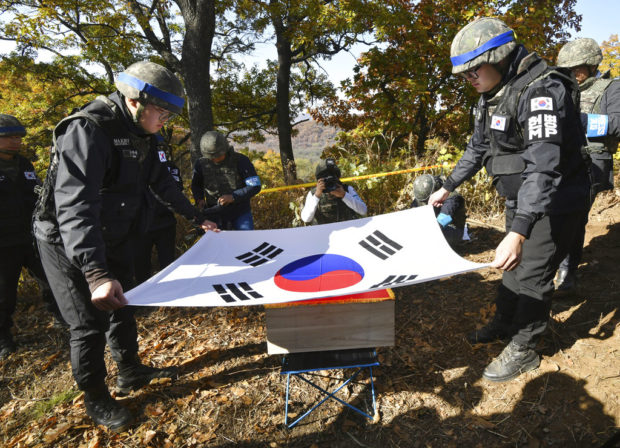Koreas, UN finish removing firearms from border village

Members of South Korea’s Defense Ministry recovery team cover a coffin containing a piece of bone believed to be the remains of an unidentified South Korean soldier killed in the Korean War with the national flag in the Demilitarized Zone (DMZ) dividing the two Koreas in Cheorwon, northeast of Seoul on Oct. 25, 2018. AP
SEOUL, South Korea — The rival Koreas and the US-led UN Command finished removing firearms and troops from a jointly controlled area at a border village on Thursday, as part of agreements to reduce decades-long animosity on the Korean Peninsula.
South Korea separately announced that its troops found what it believes are Korean War remains in another front-line area where they have been clearing land mines with North Korean soldiers. The rival Koreas plan their first-ever joint searches for war dead there after their demining work is done.
Disarming the Joint Security Area at the border village of Panmunjom and the joint searches are among a package of deals the Koreas’ defense ministers struck on the sidelines of their leaders’ summit last month. Other steps include creating buffer zones along their land and sea boundaries and a no-fly zone above the border, as well as removing some of their front-line guard posts.
On Thursday, the Koreas and the U.N. Command completed a removal of weapons, ammunition and soldiers manning guard posts at Panmunjom’s Joint Security Area, Seoul’s Defense Ministry said in a statement. The three sides earlier finished removing mines from the village.
The three sides will jointly verify their disarmament work on Friday and Saturday. Under the September deals, the two Koreas are to let 35 “unarmed personnel” from each side guard the Joint Security Area and let tourists freely move around there.
Article continues after this advertisementThe area symbolizes the Koreas’ seven decades of division. It’s where an armistice was signed at the end of the 1950-53 Korean War. Rival soldiers have faced each other only meters (feet) apart in the zone, which has been the scene of numerous incidents of bloodshed and violence. It is also a venue for talks and a popular tourist destination.
Article continues after this advertisementSoldiers and visitors were previously allowed to move freely inside the area, but the 1976 ax-killing of two American troops by North Korea at Panmunjom led to the creation of ankle-high concrete slabs that mark the border there.
The Koreas are split along the 248-kilometer (155-mile) -long, 4-kilometer (2.5-mile) -wide border called the Demilitarized Zone that was originally created as a buffer. But unlike its name, the DMZ is now the world’s most heavily fortified border. An estimated 2 million mines are peppered inside and near the DMZ, which is also guarded by barbed wire fences, tank traps and combat troops on both sides.
Officially, the entire DMZ area, including Panmunjom, is jointly overseen by North Korea and the U.N. Command. About 28,500 U.S. troops are deployed in South Korea to deter possible aggression from North Korea.
The Defense Ministry said earlier Thursday that its troops found what they believe are two sets of human remains at another DMZ spot. It was the first such discovery since South Korea began the joint demining work with North Korea on Oct. 1 at a place where one of the heaviest Korean War battles took place.
According to the ministry, a bayonet, bullets and a South Korean army identification tag with the name “Pak Je Kwon” were found along with the remains. Military records show Pak was a sergeant first class who died in a battle in 1953 in the final weeks of the Korean War.
Pak has two surviving sisters and authorities will take their DNA samples to find out if parts of the bones belong to him.
During a media visit to the site, South Korean soldiers wrapped a piece of bone in white paper and put it into a wooden box. They later wrapped the box with a national flag, placed it on a small table and offered a shot of liquor before they paid a silent tribute.
“Sgt. 1st Class Pak Je Kwon has come back to us. It’s been 65 years since he died in battle. Now, we can offer up a shot of soju (Korean liquor)” to him, South Korean President Moon Jae-in tweeted.
The area, known as Arrowhead Hill, is where South Korean and U.S.-led U.N. troops repelled a series of Chinese attacks to secure a strategically important hilltop position. South Korea said the remains of an estimated 300 South Korean, French and U.S. soldiers are believed to be in the area. The remains of a large number of Chinese and North Korean soldiers are also likely there.
The Korean War left millions dead or missing, and Seoul officials believe the remains of about 10,000 South Korean soldiers alone are still inside the DMZ.
September’s agreements received strong criticism from conservatives in South Korea that Moon’s government made too many concessions that will eventually weaken the country’s military strength at a time when North Korea’s nuclear threat remains unchanged.
Moon, a liberal who wants greater ties with North Korea, has facilitated a series of high-profile U.S.-North Korean talks, including a June summit between North Korean leader Kim Jong Un and President Donald Trump, to address the standoff over Kim’s nuclear program. /ee